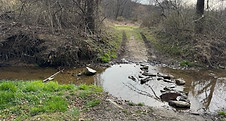ASCENT - Rationale
The Principles Behind - and Advantages of - ASCENT
Our rating system that allows people with disabilities to choose the best path or trail tailored to their individual abilities and goals for better health and quality of life,.
Builds on Federal Standards defining Universal Access Trails and Shared Use Paths. Read more.
Simple, reliable, meaning-ful & evolving scales help walkers find the trail right for them. Read more.
Focuses on easier natural trails, those that people with disabilities might first use to connect with nature. Read more.
Helps meet goals for health & quality of life using our research-based Progressive Access framework. Read more.
Separates Effort from Stress to help people with disabilities get fit on paved paths before trying natural trails. Read more.
Helps park managers and funders prioritize trail & other improvements to increase access. Read more.
Defines sources of Trail Stress that challenge the capacities of people, depending on their disability. Read more.
Can complement other trail system ratings that simply do not work for people with disabilities. Read more.
ASCENT builds on Federal Standards
I reference Universal Access (UA) standards across this site when describing all Shared Use Paths and Universal Access (UA) Trails. These are based on the summary provided in Trails for All People (see right), with specific page references. These guidelines review issues related to accessibility on these paths and trails. Text offered below and elsewhere on the site is intended to quickly orient users to general principles. Readers are encouraged to review the manual while those seeking to build Shared Use Paths or UA trails MUST rely on experienced trail designers and builders.
ASCENT builds on the specific features captured in the UA standards: Cross-Grade, Combined Running Grade, Width, Surface, and Obstacles.
ASCENT also builds on the specific thresholds captured for each of the features:
A specific feature rated as
A+ Exceeds the standard
A Meets the standard
A- Falls just short of the standard
B Clearly falls short of the standard
C Significantly exceeds the standard
ASCENT overall Trail Ratings tie directly into the features and thresholds related to Trail Stress
A specific feature rated as
-
Very Easy A natural trail that meets all UA standards except for Tread Surface, which does not exceed A-
-
Very Easy to Easy A Very Easy natural trail that includes short sections that fall just short of no more than one other UA standard (e.g., A- rating) at a time
-
Easy A Very Easy natural trail that that includes short sections that fall just short of no more than one other UA standard (e.g., A- rating) at a timeVery Easy, but includes short sections that fall just short of no more than one UA standard (e.g., A- rating) at a time
-
Easy to Hard Very Easy, but includes short sections that fall just short of no more than one UA standard (e.g., A- rating) at a time
ASCENT helps people with disabilities begin to access natural trails for better health and quality of life
ASCENT is developed primarily to help people with disabilities build from first experiences walking paved paths to then begin to explore easy natural (e.g., dirt and grass) trails. Why? Because such trails
-
Can eventually help people with disabilities become more confident on a broader range of trails
-
Are more likely than paved paths to connect people with disabilities to more beautiful natural places that increase the quality of life
-
Can often be found in many more places, making them easier to access to meet daily exercise goals
-
Can be created at a fraction of the cost of paved paths, significant increasing overall capacity with much more modest investments.

For every mile of paved path, we believe there are 2-3 miles of natural trails that could be made more useable to people with disabilities, with minor improvements
ASCENT separates Trail Effort from Trail Stress to help people with disabilities begin by building their fitness
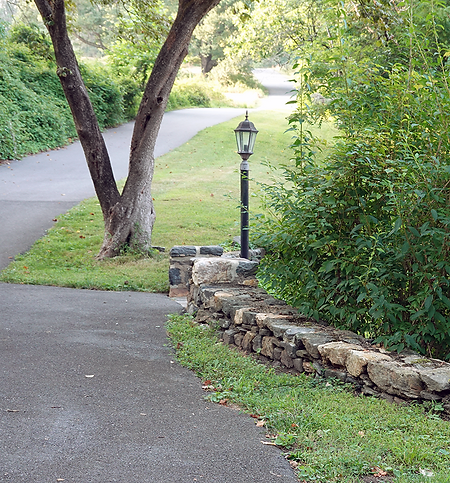
We know that Margot will take longer to walk the Oversee Farm Trail compared to a flat path of the same length, because of the grades
Read more about Trail Effort HERE
The level of fitness required to complete a walk - the Trail Effort - is determined by the
-
Length of the walk, and
-
Any slopes (Running Grades) users encounter (ratings of Running Grade are detailed elsewhere)
Why focus first on Trail Effort?
-
It can be reliably predicted (e.g., a trail that is twice as long likely takes twice the effort to complete).
-
It probably does not vary as much in people with disabilities (e.g., a trail that is twice as long will be twice as hard for anyone regardless of disability)
-
We can confidently set goals to increase fitness by choosing trails based on their length and (to a less degree) on the types of Running Grades.
Walks on paved paths are a great way for people with disabilities to
-
Improve their physical health, by setting goals to Get Moving and Get Fit, and to
-
Prepare them for their first walks on natural trails that can begin to connect them with more beautiful places that improve their quality of life.
ASCENT captures the Stress and Barriers that people with disabilities experience on natural trails
Trail Stress is the discomfort we experience or barriers we encounter while walking a natural trail. The amount of stress depends our capacity and confidence to navigate specific features that vary significantly across trails - e.g., Cross-Grades, Width, Surface, Obstacles, and steeper Running Grades.
-
Our capacity will vary depending on the nature of our disability, and the strength and skills we have developed to compensate
-
Our confidence will depend on the positive experiences we have had walking similar trails
A Trail Barrier is a feature that a person with a disability cannot overcome, or only with great difficulty (see right)
-
Example: A wheelchair user faced with stairs.
-
Barriers prevent a person from continuing their walk.

Margot will not want to hike if her feet are wet, so this stream crossing on the Lower Octararo Trail at Glenroy Preserve becomes a barrier
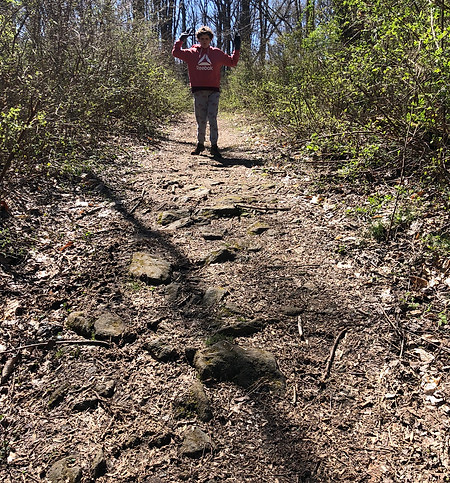
Margot can navigate rocks and roots, like these on Flint Hill Preserve. But these obstacles (rated A-) increase her stress and slow her down.
A Trail Stressor is a feature that a person with a disability finds difficult but not impossible to navigate (see left)
-
Example: 3" high rocks that a person with low vision must take care to step around and not trip on.
-
Stressors make a walk less comfortable; enough may make a walk so uncomfortable that someone with a disability does not complete it or never returns to it.
By characterizing some trail features as stressors, and by recognizing the strength and skills needed to navigate them, we begin to see how some people with disabilities may set goals to build their capacity to walk trails that are technically inaccessible (e.g., exceed UA standards).
Read more about Trail Stress HERE
Walks on easier natural trails are a great way for people with disabilities to:
-
Improve not only their physical health but also their quality of life, helping them to connect with so many more beautiful and peaceful places in nature, and;
-
Progress through specific goals (associated Stress rating), like Testing Stressors (A-), Building Capacity (B), and Getting More Adventurous (C). This helps them to to explore even more trails, become even more fit, and experience even more nature.
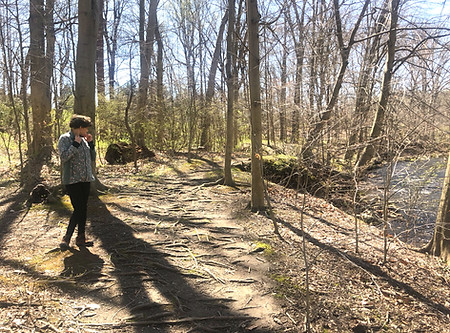
These long sections of obstacles build Margot's capacity, bringing her to a peaceful spot in White Clay Creek Preserve she might otherwise not reach.

Trails in Stateline Woods vary in terms of types and levels of stress, allowing Margot to choose one that can build her capacity without too much stress
ASCENT helps each person to find the trail just right for them
-
Separate ratings for each feature (Cross- & Running Grade, Width, Surface, and Obstacles), help each person identify which feature(s) they find stressful
-
Carefully graded stress levels - A-, B, and C - within each feature help each person choose a difficulty level that matches their current capacity and confidence
ASCENT uses simple, reliable, and meaningful ratings that will evolve and expand over time
This rating system is anchored in features recognized as important to people with disabilities (e.g., Running & Cross-Grades, Width, Surface, and Obstacles).
-
Most of the features referenced here are are simple and reliable - e.g., we can readily agree on the trail's width
-
The standard for accessibility here is meaningful - e.g., an A Rating is consistent with UA Standards, the baseline recognized as facilitating access for all users.
Through my experience helping to develop manuals for other popular scales in the field of Autism, I know how to design rating scales that can be widely and reliably adopted.
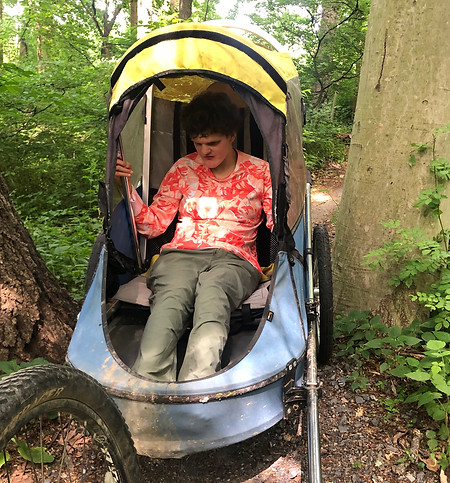
Width is a simple, reliable, and meaningful rating for a device like this adaptive stroller. The gaps between trees on the Whitley Farm Loop is never less than 32", ensuring that Margot can just squeeze through.
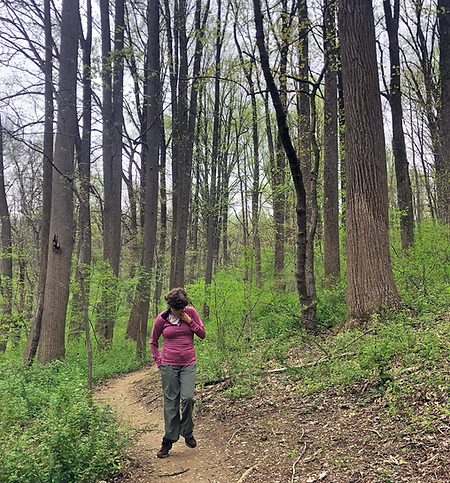
By setting goals and working gradually towards them, Margot can become more comfortable on more trails, increasing access to special places
Ratings can also guide the development of goals supporting individualized and incremental improvement for people with disabilities
-
Goals related to Fitness (Get Moving and Get Fit) requires choosing paths that are longer and/or have more challenging Combined Running Grades but with Stress rated A- or better.
-
Building Capacity and Confidence requires choosing trails with increasing levels of Trail Stress (from A to A- to B to C) in specific features of interest.
-
Thresholds for increasing levels of Trail Stress are selected to help people with disabilities take their first steps on natural trails, and increase their potential to reach goals related to Happiness (e.g., Quality of Life).
Ratings that will evolve through pilot work,
increasing the miles and range of trails identified
Rating scales are gradually developed through 6 phases demonstrating their reliability, feasibility and usefulness in a targeted region - in this case, in Chester County).
-
A survey identifying accessible facilities and points of interest in parks and preserves that include a paved path at least one mile long rated A or better is almost complete, suggesting gaps in access that improved natural trails can help to close.
-
Identifying paths at least one-half mile long across the county will establish a baseline for tracking growth in accessibility: the number of miles of paths/trails meeting UA standards.
-
Piloting the ASCENT system on A- trails will provide data on the reliability of the ratings and screen existing trails for inclusion in later phases
-
Drafting maps and descriptions to capture the variability in Trail Effort and Stress.
-
Integrating the above while extending the survey in 1 plus will help create the first comprehensive Chester County Outdoor Access Guide for more widespread distribution, and more detailed planning.

This opening at PennDell Trail is 1/2 inches too narrow to accommodate a wheelchair, barring users from a walk that otherwise meets all standards.
ASCENT can help plan successful hikes when considered together within a Progressive Access framework
Effort and Stress ratings help people with disabilities set Goals for successful walks year-round, when considered together with other elements of our Progressive Access framework...How?
-
People with disabilities like Margot have different levels of skills and confidence, depending on their particular disability.
-
Disability is not immutable: fitness, skills, and confidence grows with experience, allowing us to set Goals to explore a greater range of paths and trails.
-
We adjust expectations based on these other elements - Accommodations, Supports, Interests, and Other Conditions - to help make the overall experience even more enjoyable.
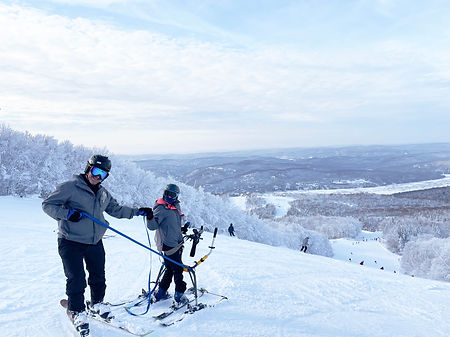
I honed the model of Progressive Access while teaching Margot how to ski with me.

A key accommodation when skiing is ensuring that staff give us time to get on the chairlift or gondola.
Accommodations in the choice of facilities and procedures make a BIG difference
These are widely used but under-appreciated strategies for anticipating stressors and increasing comfort.
-
Time: Allowing more time to complete a walk, or choosing a time when a park is less crowded or your hiker has more energy.
-
Facilities: Selecting a shaded trail on a hot day, or one that includes benches for breaks
-
Procedures: Building in breaks for snacks or bathroom access.
Supports can decrease stress
Choosing the right support can help a person with disabilities be more conformtable while still challengin them to build skills and confidence
-
People: A helper can offer an arm to lean on while navigating obstacles
-
Equipment: A walking stick can offer support while still challenging the person to build skills

Margot's snow slider gives support but allows her to lean into turns and shift her skis

Margot LOVES to go fast, so a run that allows us to safely get more speed can counter other stressors.
Tapping into Interests to increase motivation
I can more comfortably increase the challenge when I know this experience will be interesting because it
-
Uses a familiar path: A familiar trail makes everything easier!
-
Builds on familiar routines: Changes in the overall routine (getting to and from the starting point, etc.) can sometimes increase overall stress.
-
Brings us to a favorite kind of place: For Margot, a walk that brings us to a stream is always preferred, especially if she can play in the water
-
Offer a favorite experience: Margot loves feeling the wind in her hair, and will always put up with more if she can get a bit of speed!!
Adjusting expectations based on Other Conditions
I know to lower expectations based on
-
Weather: More challenging conditions indicate the need to be more conservation in what we can do.
-
Mood: I change expectations on the fly by constantly monitoring Margot's energy and affect

I know that I have more flexibility to try new runs or extend the day when I see Margot is in great mood!
ASCENT can help guide improvements to increase access for people with disabilities
ASCENT offers a low cost way to significantly increase the number of miles of trails that can be used by people with disabilities to improve their health and quality of life
-
It can help park managers to identify trails they might already have or could easily improve to increase access for those with mobility challenges
-
It can help regional leaders set priorities to close gaps in access to nature at a reasonable cost
-
This is especially important for people with disabilities and other conditions that limit their mobility, a population often underserved by our parks and at high risk for related health problems

When we map access to paths that support regular walks for fitness, we discover gaps that increasing the useability of natural trails can help to close
ASCENT supplements existing rating systems that just do not work for people with disabilities
Some rating systems span a very wide range of difficulty, and do not offer finer distinctions important to those with mobility challenges. Other rating systems not only span a very wide range of lengths, but they also confound length (Effort) and difficulty (Stress).
-
In the 5 point system described by the National Park Service, Level 5 includes hikes 5-8 miles long with steep inclines that would be "challenging for an unconditioned person".
-
The system used in Australia's parks (see right) also addresses whether wayfinding skills may be needed.

Other ratings like those adopted by Pennsylvania (p. 12) and pictured to the right include more descriptors relevant to those with mobility challenges but may still be too vague.
Many systems also ignore the kinds of paths found in local parks, which can be so helpful for people with disabilities who just want to Get Moving.
Other Sources of Confusion
Trail builders must comply with federal accessibility standards only "to the extent practicable"
In practice, this means that Multi-Use and Walking Paths are permitted to exceed allowable grades because of the terrain, like in the example listed below. When only local or private funds to build these paths and trails have no obligation to adhere to accessibility standards. In practice, the high cost of multi-use paths means that states, counties, and municipalities must rely on federal dollars (including pass-through grants to states and counties), and so they must strive to comply with these standards.
CASE STUDY The descent from Alapocas Drive into Brandywine Park in the westernmost section of the Northern Delaware Greenway includes more than 160' of difficult downhill grades (up to 20%) that would make this uncomfortable for many cyclists and all but the most experienced wheelchair users. You can see this in the grades to the left, with each dot marking a 10' section, and dark blue indicating difficult downhill grades. Like many shared use paths, no resting intervals are provided.
A trail meeting full accessibility standards is not always an easy one
A trail does not have to be uniformly flat to meet UA standards. A path with Running Grades rated as A can have uphill section of any length as long as these do not exceed 5%. It can have uphill sections of 5-8.33% for up to 30', and uphill sections of 8.33-10% for up to 10'. And it can have any number of these as long as there are resting intervals in between. These can all increase Trail Effort.
Even a path with Running Grades rated as A+ can require effort! This beautiful 600' boardwalk section of the Jack Markell Trail complies with standards for shared use paths because it never exceeds a 5% grade. Nonetheless, its length would make it difficult - and potentially stressful - for users with disabilities who are less experienced or less fit.











